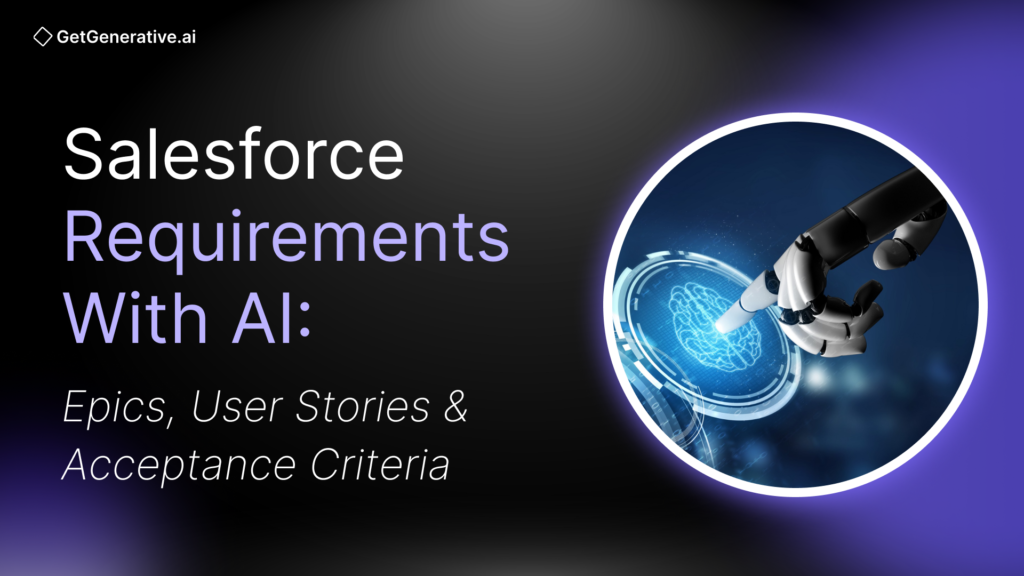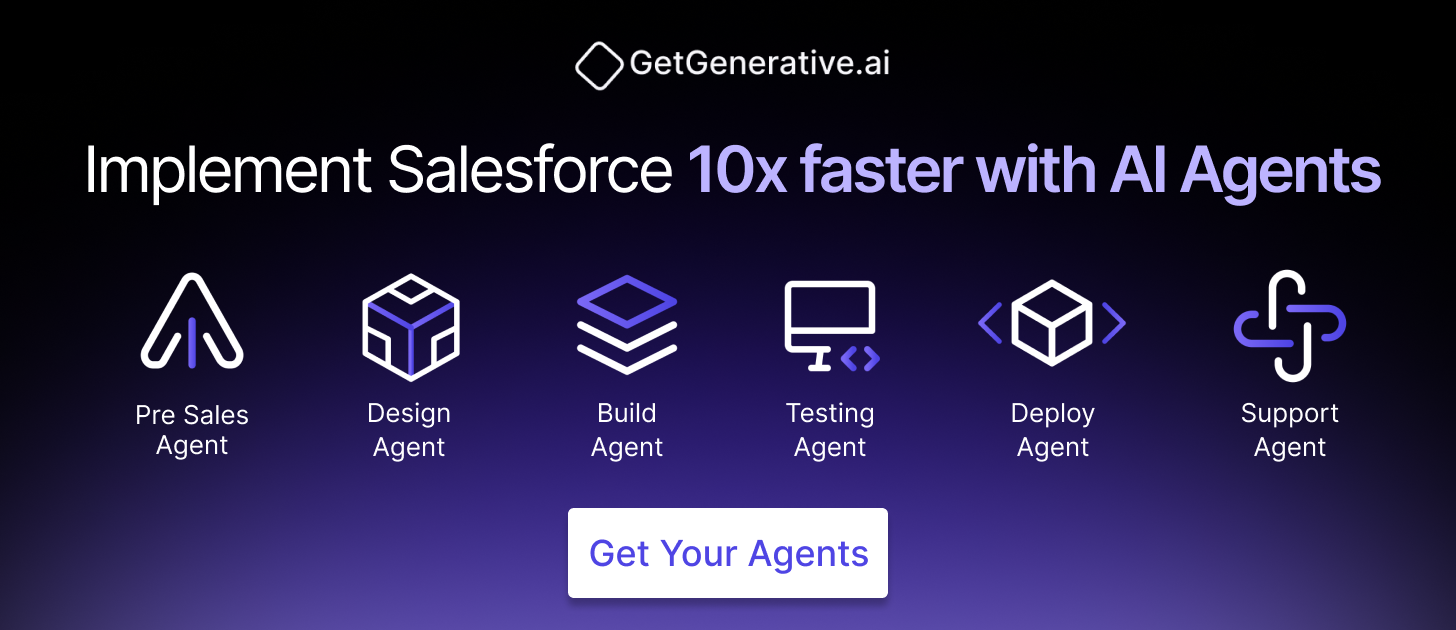Salesforce Requirements with AI: Epics, User Stories & Acceptance Criteria
Getting the Salesforce project requirements right is mission-critical. Whether it’s high-level epics or granular acceptance criteria, clarity in requirements directly drives on-time, on-budget, high-quality delivery. Yet, traditional methods of capturing Salesforce project requirements often fall short in today’s fast-paced, complex implementations.
With the launch of innovations like Einstein GPT—touted as “the world’s first generative AI for CRM” — Salesforce has set the stage for a fundamental shift. Generative AI is redefining how teams capture, refine, and manage requirements.
By combining Salesforce’s AI innovations with agile best practices, project teams now have the opportunity to reimagine the requirement lifecycle, making it faster, smarter, and more resilient to change.
This blog explores how AI is transforming Salesforce project requirements—specifically epics, user stories, and acceptance criteria. Let’s get started!
Epics, User Stories, and Acceptance Criteria
In agile Salesforce projects, epics, user stories, and acceptance criteria form the critical foundation that transforms business vision into technical execution.
Each plays a distinct yet interconnected role:
- Epics represent large business objectives—broad, strategic initiatives that require further breakdown.
- User stories are smaller, actionable requirements nested within an epic, capturing a specific user need from an end-user’s perspective. They often follow the simple but powerful format:
“As a [user], I want [goal] so that [reason].” - Acceptance criteria define the specific conditions that must be met for a user story to be considered complete, offering a shared understanding of success across all stakeholders.
In practice, well-written acceptance criteria serve as a safety net against ambiguity, guiding developers, testers, and business users alike toward a clear outcome. They also play a vital role in:
- Reducing miscommunication
- Guiding test case creation
- Preventing scope creep by setting firm boundaries on what “done” looks like
In a Salesforce environment, where custom configurations, third-party integrations, and automations often converge, the cost of unclear requirements can be enormous.
Research shows that poorly defined requirements contribute to 35% of project failures (PMI Pulse of the Profession Report).
Seasoned Salesforce professionals know the signs all too well:
Missed details lead to costly rework, delayed go-lives, frustrated users, and lost business value.
Strong epics, user stories, and acceptance criteria are not just documentation artifacts—they are the blueprint for successful Salesforce project delivery.
The High Stakes of Traditional Requirements Gathering
Despite the recognized importance of clear requirements, traditional methods for gathering Salesforce project requirements come with significant risks.
Conventional approaches—such as stakeholder workshops, whiteboarding sessions, and extensive BRD (Business Requirements Document) write-ups—are often:
- Time-consuming
- Resource-intensive
- Prone to human error and misinterpretation
In large Salesforce programs, requirements typically evolve over weeks or months. In that time, gaps, misunderstandings, and assumptions can easily creep in.
Busy executives may describe business needs at a high level, leaving business analysts to fill in critical blanks. Developers then interpret those written stories, and even small misalignments can snowball into:
- Mismatched solutions
- Budget overruns
- Rework cycles
- Stakeholder dissatisfaction
It’s no surprise that poor requirements gathering is cited in 47% of project failures across industries (Project Management Institute).
Adding to the complexity, Salesforce’s “clicks-not-code” paradigm, which enables rapid declarative development, introduces frequent shifts during execution. Teams may uncover platform limitations or new out-of-the-box features mid-project, necessitating requirements adjustments.
Keeping requirements documents updated and synchronized with rapid Salesforce changes becomes an uphill battle.
For senior Salesforce consultants and CXOs, this leads to a familiar frustration:
“Why are we still discovering critical gaps in UAT or post-go-live?”
Clearly, a smarter, more dynamic approach is urgently needed to:
- Capture requirements accurately
- Maintain alignment across teams
- Adapt swiftly to inevitable changes
This is where AI offers a true paradigm shift—bringing speed, consistency, and even predictive insights into the heart of the Salesforce requirements process.
How AI is Transforming Salesforce Requirement Practices
The rise of generative AI, powered by advanced large language models (LLMs), is revolutionizing the way Salesforce teams capture, refine, and manage requirements.
Instead of starting with a blank page, consultants can now leverage AI to:
- Draft initial epics, user stories, and acceptance criteria
- Summarize stakeholder discussions
- Identify missing requirements or potential risks
- Refine documentation at the speed of conversation
Importantly, AI is not replacing human expertise—it’s augmenting it.
Senior Salesforce professionals, architects, and business analysts remain critical to validate, customize, and strategically align the AI outputs.
How GetGenerative.ai Adds Value Across the Requirement Lifecycle:
Accelerating Discovery and Epic Definition
GetGenerative.ai starts by analyzing inputs such as stakeholder interviews, meeting notes, and uploaded documents. The Pre-Sales Agent automatically identifies high-level themes and breaks them down into epics, forming the backbone of the requirements structure. This layered approach ensures no major needs are overlooked, even when starting with unstructured data.
Example: Instead of manually summarizing a 2-hour discovery workshop, GetGenerative.ai can extract 5 major epics and 15 structured high-level user stories within minutes, reducing pre-sales cycle time and accelerating proposal creation.
AI-Assisted User Story Creation
With GetGenerative.ai’s Design Agent, consultants can transform each requirement or epic into well-structured user stories and associated acceptance criteria. The AI creates metadata-rich stories, tagging each one with its associated theme, epic, release cycle, status, and priority. Stories are editable, filterable, and fully traceable.
Example: A requirement like “Enable partner fund requests” becomes a user story with acceptance criteria such as form fields, approval rules, and error scenarios—auto-generated from context. The platform also integrates with Jira to push stories directly, streamlining agile collaboration.
Generating Acceptance Criteria and Test Scripts
The Testing Agent takes finalized user stories and auto-generates detailed acceptance criteria and matching manual test cases. These follow standard formats (e.g., Given-When-Then) and include edge cases, preconditions, steps, and expected results. This ensures full test coverage from the start.
Benchmark Insight: In internal tests, GetGenerative.ai generated 900 test cases in minutes, cutting manual QA documentation time by up to 80%. The acceptance criteria matched human-created ones 85–90% of the time.
Acting as a Salesforce Expert Assistant
GetGenerative.ai isn’t just generating content—it’s trained on 30,000+ Salesforce help pages to recommend pre-built solutions for each requirement. Consultants can review and insert Salesforce-native options (e.g., Digital Engagement, Email-to-Case) directly into their implementation workbook, removing guesswork.
Salesforce’s AI-Powered Toolkit for Requirements Gathering
Recognizing the massive potential of AI, Salesforce has strategically expanded its own AI ecosystem to directly support project workflows, including requirements gathering, implementation, and management.
Today, Salesforce teams can tap into a growing set of native AI-powered tools designed to make the requirements lifecycle smarter, faster, and more secure.
DevOps Center
Salesforce DevOps Center modernizes how changes are tracked, approved, and released on the Salesforce platform.
At its core, it introduces Work Items—records that act as linked user stories tied directly to source control branches and deployment pipelines.
For requirement gathering, this means:
- Every user story and requirement is traceable from the backlog to the release.
- Changes are governed by agile best practices rather than fragmented processes.
According to Salesforce, DevOps Center “brings DevOps best practices to your development team.”
By leveraging DevOps Center, organizations lay the foundation for future AI integrations, where AI could recommend backlog grooming improvements, auto-generate release notes, or validate user story completeness dynamically.
Einstein GPT
Einstein GPT represents Salesforce’s major leap into generative AI.
It’s designed to create content—whether that’s drafting emails, writing code snippets, or summarizing customer interactions—using natural language prompts.
For requirements gathering, Einstein GPT enables:
- Drafting of user stories, validation rules, and Flows based on plain language inputs
- Auto-summarization of case discussions and requirements workshops
- Assistance in generating standard Salesforce configurations aligned with stated needs
Furthermore, Einstein GPT is built with an enterprise security mindset, incorporating Salesforce’s Einstein Trust Layer to ensure outputs maintain compliance and data privacy.
Salesforce AI Cloud: Trust, Scale, and Connected Intelligence
Salesforce AI Cloud brings all Salesforce AI innovations under one umbrella, designed to:
- Deploy AI at enterprise scale
- Ensure secure use of company data
- Seamlessly integrate with Salesforce Customer 360
With AI Cloud, Salesforce customers can trust that AI outputs – user stories, requirement summaries, or automation suggestions – are grounded in secure, real-time CRM data.
Notably, AI Cloud leverages Salesforce’s Data Cloud as its engine, ensuring AI recommendations are highly contextualized to a company’s actual Salesforce environment.
BluePrint For Salesforce + AI
Here’s a clear blueprint to capitalize on this new era:
1. Combine AI with Human Expertise
Treat AI as a highly capable team member—not a replacement.
Let AI generate first drafts of epics, user stories, and acceptance criteria, then have experienced consultants review, tailor, and validate them.
2. Invest in Enablement and AI Literacy
Train your teams on prompt engineering and AI tool capabilities (like Einstein GPT and GetGenerative.ai Agents).
Just as teams master Salesforce Clouds or AppExchange solutions, they must now master how to work with AI.
3. Start Small—Pilot AI in Real Projects
Identify a current or upcoming Salesforce project to pilot AI-enhanced requirements gathering.
Set clear goals such as:
- Reducing story drafting time by 50%
- Improving stakeholder clarity ratings
Track results rigorously.
Early wins will build momentum and confidence across teams and leadership.
4. Leverage Trusted Salesforce AI Platforms
Use Salesforce-native AI tools like Einstein GPT and AI Cloud to ensure:
- Data security (protected by the Einstein Trust Layer)
- Tight CRM integration
- Compliance with enterprise governance standards.
If experimenting with external AI, anonymize sensitive data and vet providers carefully.
Governance and data security must be non-negotiable priorities.
5. Integrate AI into Existing Processes
Don’t treat AI-assisted requirements as a separate side project.
Embed AI naturally into your agile, scrum, and DevOps workflows.
Examples:
- Add “AI Draft Review” into your definition of done
- Let AI auto-generate draft stories in Jira or DevOps Center
- Use Slack GPT to summarize daily standup discussions into backlog updates
The key is to make AI a seamless part of delivery, not an afterthought.
6. Measure, Celebrate, and Scale
Treat AI adoption as a strategic initiative.
Measure KPIs like:
- Reduction in requirements documentation time
- Increase in first-pass UAT success rates
- Stakeholder satisfaction scores
Final Thoughts
Blending AI with Salesforce requirements gathering isn’t about cutting corners—it’s about unlocking new levels of speed, precision, and agility.
See how simple Salesforce delivery can be.
With GetGenerative.ai, you can create complete proposals, scope plans, and user stories—start to finish—in one workspace.
Explore the AI-powered way to run better projects.
Book a demo today!




